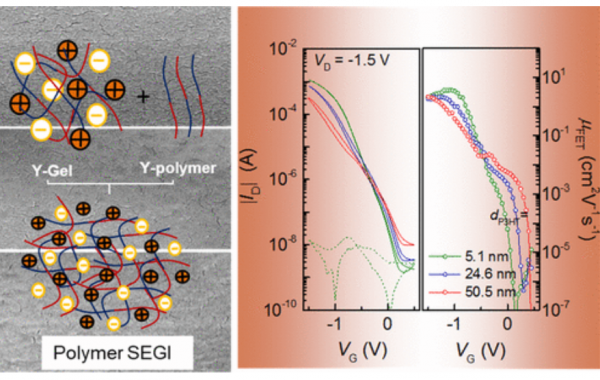Polymer Electrolyte Blend Gate Dielectrics for High-Performance Ultrathin Organic Transistors: Toward Favorable Polymer Blend Miscibility and Reliability
- 저자
- Benjamin Nketia-Yawson*, Grace Dansoa Tabi, and Yong-Young Noh*
- 저널명
- ACS Applied Materials & Interfaces, 11, 19, 17610–17616 (2019)
- 년도
- 2019
- Link
- https://doi.org/10.1021/acsami.9b03999 689회 연결
[Abstract]
We report on systematic mobility enhancements in electrolyte-gated organic field-effect transistors (OFETs) by thinning down the active layer and exploiting polymer solid-state electrolyte gate insulators (SEGIs). The SEGI is composed of homogeneous poly(vinylidene fluoride-co-hexafluoropropylene) [P(VDF-HFP)] polymer solution–ion gel blends of high areal capacitance of >10 μF cm–2 at 1 Hz. By scaling up the poly(3-hexylthiophene) (P3HT) semiconducting layer by 1 order of magnitude (5–50 nm), an ultraviolet photoelectron spectroscopy examination reveals a downward vacuum-level shift generating a substantial hole injection barrier that originates from different interfacial dipole layer formations. The ultrathin (5.1 nm) P3HT FETs outperformed the other devices, exhibiting stable device characteristics with a highest field-effect mobility of >2 cm2 V–1 s–1 (effective mobility of 0.83 ± 0.05 cm2 V–1 s–1), on/off ratio of ∼106, low threshold voltage of <−0.6 V, and low gate-leakage current levels of ∼105 below the on-current levels in 10 μm channel length devices. We observed a positive threshold voltage shift in the P3HT/SEGI FETs with decreasing semiconductor thickness. The aforementioned mobility is at least 10 times greater than that of neat P(VDF-HFP) devices. The significant FET performance is attributed to a better insulator/semiconductor interface, efficient hole injection from the Au electrode resulting in a low contact resistance of <500 Ω cm, and boosted charge-carrier densities in the transistor channel. This work demonstrates an excellent approach for carrier mobility enhancement and reliability assessment in low-voltage-operated electrolyte-gated OFETs.
